Wacom 21UX, DTK-2100 User Manual
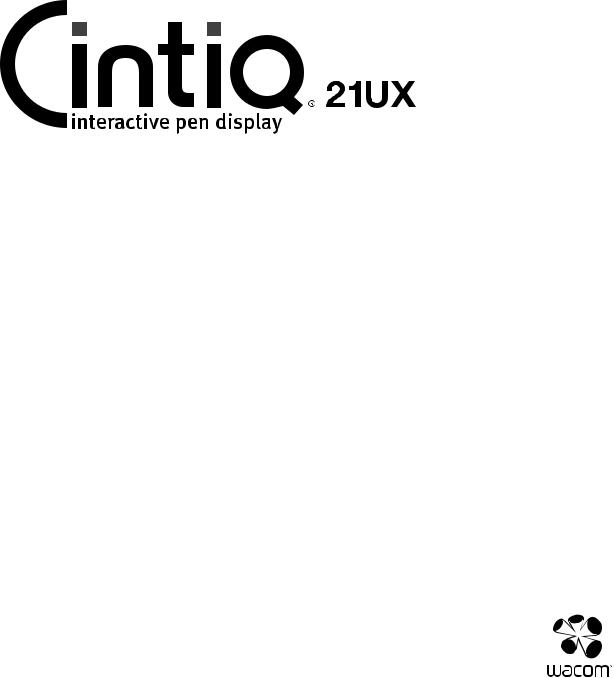
Installation Guide & Hardware Manual
Model: DTK-2100
Wacom Cintiq® 21UX
Installation Guide & Hardware Manual Version 1.0, Rev A1910
Copyright © Wacom Co., Ltd., 2010
All rights reserved. No part of this manual may be reproduced except for your express personal use. Wacom reserves the right to revise this publication without obligation to provide notification of such changes.
Wacom does its best to provide current and accurate information in this manual. However, Wacom reserves the right to change any specifications and product configurations at its discretion, without prior notice and without obligation to include such changes in this manual.
The above year indicates when this manual was prepared. However, the date of release to the users of the “manual” is simultaneous with the introduction into the market of the applicable Wacom product.
DuoSwitch is a trademark, and Cintiq and Wacom are registered trademarks of Wacom Co., Ltd.
Adobe, Reader, and Photoshop are either registered trademarks or trademarks of Adobe systems Incorporated in the United States and/or other countries. Microsoft, Windows, and Vista are either registered trademarks or trademarks of Microsoft Corporation in the United States and/or other countries. Apple, the Apple logo, and Macintosh are trademarks of Apple Computer, Inc., registered in the U.S. and other countries.
Any additional company and product names mentioned in this documentation may be trademarked and/or registered as trademarks. Mention of third-party products is for informational purposes only and constitutes neither an endorsement nor a recommendation. Wacom assumes no responsibility with regard to the performance or use of these products.
ExpressKey is a registered trademark of Ginsan Industries, Inc., and is used with permission.

INTRODUCTION AND OVERVIEW
The Wacom® Cintiq® interactive pen display combines the benefits of a Liquid Crystal Display (LCD) with the control, comfort, and productivity of Wacom’s cordless, battery-free pen technology. This gives you a direct pen-on-screen interface for your computer.
The basic components of your Cintiq include a Wacom pen tablet internally mounted behind a TFT color display, the Wacom Grip Pen, and a modular display stand.
This manual describes the installation and use of your Cintiq, Grip Pen, and display stand.
•See “Unpacking your Cintiq” on page 9 before setting up the Cintiq stand or unpacking the Cintiq pen display.
•The display stand allows you to easily rotate the pen display to any orientation, and to adjust the incline of the working surface. See “Setting up the Cintiq stand” on page 10 to learn more.
•To learn about the many features of your product, see “Your Cintiq interactive pen display” on page 14.
•Follow all instructions carefully when installing your product. See “Installation” on page 17.
•There are many ways to use Cintiq. See “Working with your Cintiq” on page 24 for details.
•Use the Wacom Tablet control panel to customize your pen and pen display settings. To learn more, see “Customizing” on page 34.
The following information is not included with this product: information about your specific computer hardware or operating system, or information about your application software. Your best source for this information is the set of manuals and discs that came with your hardware, operating system, or application.
Wacom’s philosophy is to continually improve all of its products. As a result, engineering changes and improvements are made from time to time. Therefore, some changes, modifications, and improvements may not be covered in this document.
Introduction and overview
Page 1
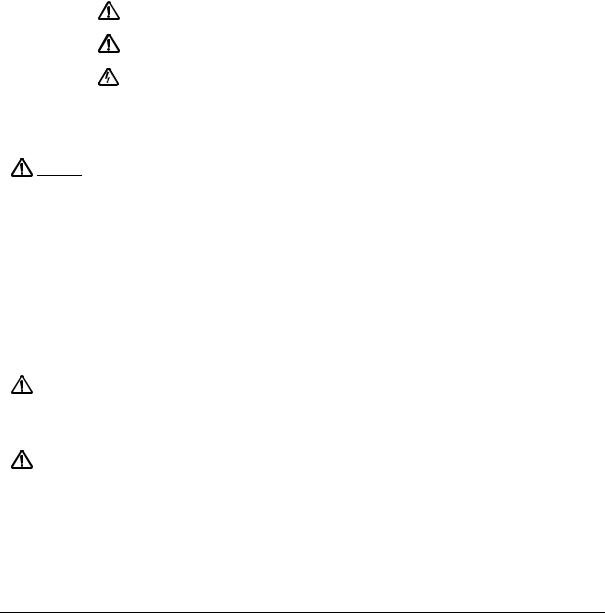
PRECAUTIONS ON USE AND HANDLING
To ensure the safe usage of your product, be sure to follow all instructions, cautions, and warnings found within this manual. Failure to do so could cause the loss of data or damage to your computer. Failure to do so could also void your warranty, in which case Wacom shall have no responsibility to repair or replace the product.
Warning |
This symbol indicates an item that, if disregarded, may lead |
|
to loss of human life or serious injury. |
||
|
||
Caution |
This symbol indicates an item that, if disregarded, may lead |
|
to human injury or damage to personal property. |
||
|
||
Warning |
This symbol indicates an item that, if disregarded, may lead |
|
to loss of human life or serious injury. |
||
|
Exercise due care and diligence whenever engaging in a described action.
PHYSICAL LOCATION
The interactive pen display is solely applicable in normal office environments but may be Warning used also as center consoles in climate controlled environments. The product was
tested by Wacom for the usage in a normal office environment only and there was no particular inspection with regards to its compatibility in medical and military application areas. In addition, the interactive pen display is neither waterproofed nor explosionresistant. It serves and can be used solely as a passive display and input device. In all applications that are not designated for its sole usage, no information on the functionality and possible malfunctions of the interactive pen display can be supplied due to inadequate execution of tests. The adoption of the interactive pen display in other application areas than normal office environments is at the user’s risk.
ENVIRONMENT
Temperature and humidity
•Operating temperature and humidity: 5° to 35°C, 20 to 80% RH
•Storage temperature and humidity: -10° to 60°C, 20 to 90% RH
Do not use or store Cintiq where:
Caution
• Temperature changes are severe or exceed specifications (e.g., outdoors or inside
a vehicle).
•The pen display, the Grip Pen, and the Cintiq stand are exposed to direct sunlight or heat from an appliance, or are exposed to water or any other kind of liquid.
Do not use Cintiq in a dusty environment; this may damage the unit.
Caution
Precautions on use and handling Page 2
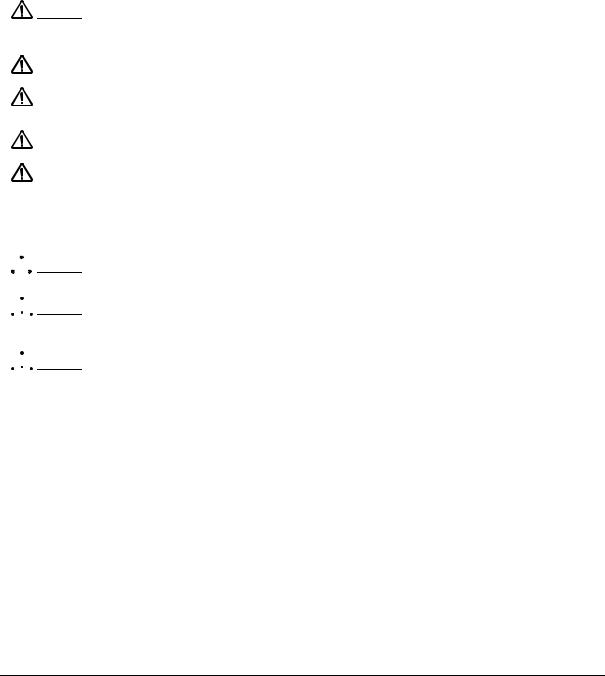
USAGE
Only use a power adapter specified for use with your Cintiq. If a different type of power Warning adapter is used, Cintiq will not work properly or may be damaged. Using a different type of
power adapter also has the potential to result in fire. Use of a different power adapter will void your warranty.
Be sure to use a grounded power source when applying power to Cintiq.
Caution
Do not connect or disconnect the video or power cables while Cintiq or your computer are Caution turned on; this may damage the display or computer video card. In this case, Wacom shall
have no responsibility to repair or replace the product.
Caution |
This product is for use with a DVI or VGA video card; using an inappropriate video card may |
|
damage Cintiq. |
||
|
Do not block the rear panel ventilation holes; this may overheat and damage the unit.
Caution
When not using Cintiq for long periods of time, unplug the power adapter from the AC outlet.
HANDLING
 Warning
Warning
 Warning
Warning
 Warning
Warning
High Voltage. Do not open or disassemble the Cintiq interactive pen display. There is a risk of electrical shock when the casing is open. This will also void your warranty and Wacom shall have no responsibility to repair or replace the product.
Do not operate the display stand incline adjustment levers when Cintiq is not mounted
on the stand, and do not lift the stand by the adjustment levers; the stand is spring-loaded and may cause injury or damage if released without the weight of Cintiq on the stand. Improper operation may lead to physical injury or damage to the stand.
When moving Cintiq to a different location, either:
•remove the display unit from the stand and then move both items separately (see “Removing Cintiq from the display stand” on page 13),
•or use the lock screws to fix Cintiq to the stand (see “Optional display configurations” on page 61).
Before moving Cintiq, first adjust the stand to its full upright position; this will reduce the spring tension so that the stand will not accidentally release and snap shut. If the display unit is in landscape orientation, use one hand to grasp the bottom of the display and with your other hand grasp the back of the stand. Be sure to lift on both the display and the stand so that the stand will not separate from the display when moving Cintiq.
If Cintiq is in portrait orientation or has been locked to the stand with the rotation lock screws, the stand will not separate from the display unit and Cintiq can be safely lifted by grasping the display unit with both hands.
Always follow the instructions in “Removing Cintiq from the display stand” on page 13 to remove the display unit from the stand.
Precautions on use and handling Page 3
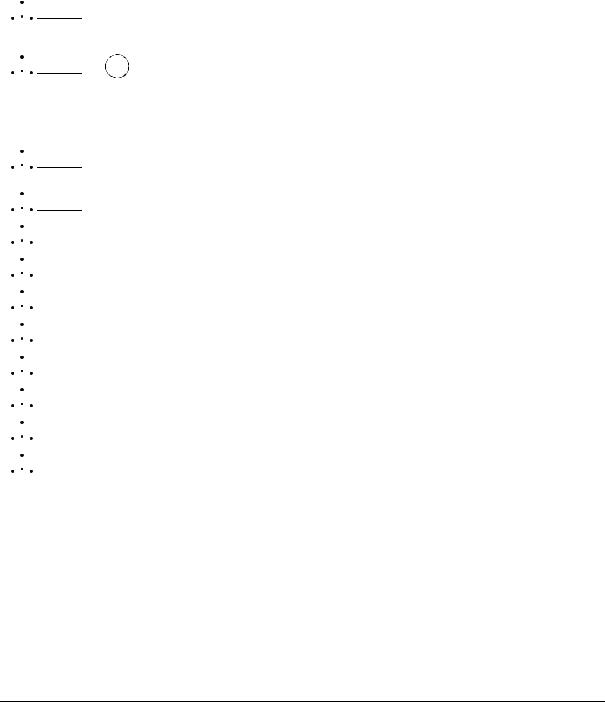
 Warning
Warning
 Warning
Warning
 Warning
Warning
 Warning
Warning
 Caution
Caution
 Caution
Caution
 Caution
Caution
 Caution
Caution
 Caution
Caution
 Caution
Caution
 Caution
Caution
 Caution
Caution
If the LCD screen has been damaged, DO NOT touch any liquid that may be leaking from it; this liquid is an irritant. In case of contact with skin, eyes, or mouth, rinse immediately with running water for at least 15 minutes or more. If contact is made with the eyes or mouth, also consult a physician.
Hg – LAMP(S) INSIDE THIS PRODUCT CONTAIN MERCURY AND MUST BE RECYCLED OR DISPOSED OF ACCORDING TO LOCAL, STATE OR FEDERAL LAWS.
The pen display has a backlight which contains mercury (Hg). Be sure to dispose of properly, and to manage any disposal of this unit in accordance with your local ordinances and laws.
Do not disassemble the Cintiq stand. Improper disassembly could result in physical injury or damage to the stand. In this case, Wacom shall have no responsibility to repair or replace the product.
Choking hazard. Prevent children from swallowing the pen tip or side switch. The pen tip or side switch may accidentally be pulled out if children are biting on them.
Do not disassemble the Grip Pen. This may cause the device to malfunction. In this case, Wacom shall have no responsibility to repair or replace the product.
Do not scratch the display screen. Avoid placing sharp objects on the display screen surface.
Avoid intensive shock or vibration to Cintiq, the Cintiq stand, or the Grip Pen. Hitting or dropping Cintiq may damage the display screen or other components.
Do not put heavy articles on the pen display or push against it with a strong force; this may damage the display screen or break the Cintiq stand locking mechanism.
Do not place heavy articles on the pen display cabling, repeatedly bend the cables sharply, or apply heavy stress to the cable connectors; this may damage the unit or cabling.
Do not store the pen display on a surface that would excessively bend or crimp the cable.
If your pen display has a coated surface, a worn pen nib that is sharp or angular may cause damage. Replace the pen tip if necessary.
Do not use any organic solvent (e.g., alcohol) or even mild detergent to clean the display screen. Use of these cleaners can damage the display screen. Damage of this kind is not covered by the manufacturer's warranty.
•Before cleaning, always disconnect your product from the AC power source.
•To clean the display screen, use an anti-static cloth or a slightly damp cloth.
When cleaning, apply only a light amount of pressure to the display screen and do not make the surface wet.
•To clean the Cintiq casing, Cintiq stand, or Grip Pen, use a soft cloth with mild detergent (such as dish washing liquid) diluted with water.
Precautions on use and handling Page 4

Do not expose Cintiq to high voltage electrostatic discharges or to a build-up of an Caution electrostatic charge on the LCD screen. This may result in a temporary discoloration and
blotching of the display. If discolorations occur, leave the display on and the discolorations should disappear within a few hours.
Reuse, recycling and recovery. You are urged to recycle this product when replacing it with a newer product or when it has outlived its useful life by bringing it to an appropriate collection point for recyclable materials in your community or region. By doing this, you can help improve the environment of your community as well as minimize the potential negative effects created, should any hazardous substance that may possibly be present within waste material reach the environment during the disposal process.
Within the European Union, users are required not to dispose of Waste Electrical and Electronic Equipment (WEEE) as unsorted municipal waste, according to the Directive 2002/96/EC of the European Parliament and of the Council of 27 January 2003, or the corresponding local laws of the Member States. Products for which this is applicable will be marked with the WEEE symbol shown at the beginning of this note unless this is not feasible because of the size or the function of the product. Wacom products are subject to the Directive 2002/96/EC and therefore you should always collect them separately and bring them to the appropriate collection point in your community or region.
Wacom pen display products comply with the European Union RoHS Directive 2002/95/EC (RoHS Directive).
Precautions on use and handling
Page 5

TABLE OF CONTENTS
INTRODUCTION AND OVERVIEW . . . . . . . . . . . . . . . . . . . . . . . . . . . . . . . . . . . . . . . . . . .1
PRECAUTIONS ON USE AND HANDLING . . . . . . . . . . . . . . . . . . . . . . . . . . . . . . . . . . . .2 Physical location . . . . . . . . . . . . . . . . . . . . . . . . . . . . . . . . . . . . . . . . . . . . . . . . . . . . . . . .2 Environment . . . . . . . . . . . . . . . . . . . . . . . . . . . . . . . . . . . . . . . . . . . . . . . . . . . . . . . . . . .2 Usage . . . . . . . . . . . . . . . . . . . . . . . . . . . . . . . . . . . . . . . . . . . . . . . . . . . . . . . . . . . . . . . .3 Handling . . . . . . . . . . . . . . . . . . . . . . . . . . . . . . . . . . . . . . . . . . . . . . . . . . . . . . . . . . . . . .3
UNPACKING YOUR CINTIQ . . . . . . . . . . . . . . . . . . . . . . . . . . . . . . . . . . . . . . . . . . . . . . |
.9 |
Setting up the Cintiq stand . . . . . . . . . . . . . . . . . . . . . . . . . . . . . . . . . . . . . . . . . . . . . . . |
10 |
Unpacking and mounting the Cintiq pen display . . . . . . . . . . . . . . . . . . . . . . . . . . . . . . . |
11 |
Adjusting the display incline . . . . . . . . . . . . . . . . . . . . . . . . . . . . . . . . . . . . . . . . . . . . |
12 |
Adjusting rotation . . . . . . . . . . . . . . . . . . . . . . . . . . . . . . . . . . . . . . . . . . . . . . . . . . . . |
13 |
Removing Cintiq from the display stand . . . . . . . . . . . . . . . . . . . . . . . . . . . . . . . . . . |
13 |
YOUR CINTIQ INTERACTIVE PEN DISPLAY . . . . . . . . . . . . . . . . . . . . . . . . . . . . . . . . . .14 Front view . . . . . . . . . . . . . . . . . . . . . . . . . . . . . . . . . . . . . . . . . . . . . . . . . . . . . . . . . . . . .14 Rear view . . . . . . . . . . . . . . . . . . . . . . . . . . . . . . . . . . . . . . . . . . . . . . . . . . . . . . . . . . . . .15 Pen features . . . . . . . . . . . . . . . . . . . . . . . . . . . . . . . . . . . . . . . . . . . . . . . . . . . . . . . . . . .16
INSTALLATION . . . . . . . . . . . . . . . . . . . . . . . . . . . . . . . . . . . . . . . . . . . . . . . . . . . . . . . .17 System requirements . . . . . . . . . . . . . . . . . . . . . . . . . . . . . . . . . . . . . . . . . . . . . . . . . . . .17 Step 1: display installation . . . . . . . . . . . . . . . . . . . . . . . . . . . . . . . . . . . . . . . . . . . . . . . .18 Step 2: pen tablet installation . . . . . . . . . . . . . . . . . . . . . . . . . . . . . . . . . . . . . . . . . . . . . .22 USB cable installation . . . . . . . . . . . . . . . . . . . . . . . . . . . . . . . . . . . . . . . . . . . . . . . .22 Software installation . . . . . . . . . . . . . . . . . . . . . . . . . . . . . . . . . . . . . . . . . . . . . . . . . .23
WORKING WITH YOUR CINTIQ . . . . . . . . . . . . . . . . . . . . . . . . . . . . . . . . . . . . . . . . . . . .24 Setting up your work area . . . . . . . . . . . . . . . . . . . . . . . . . . . . . . . . . . . . . . . . . . . . . . . .24 Using the Grip Pen . . . . . . . . . . . . . . . . . . . . . . . . . . . . . . . . . . . . . . . . . . . . . . . . . . . . . .26 Holding the pen . . . . . . . . . . . . . . . . . . . . . . . . . . . . . . . . . . . . . . . . . . . . . . . . . . . . .26 Positioning . . . . . . . . . . . . . . . . . . . . . . . . . . . . . . . . . . . . . . . . . . . . . . . . . . . . . . . . .27 Clicking . . . . . . . . . . . . . . . . . . . . . . . . . . . . . . . . . . . . . . . . . . . . . . . . . . . . . . . . . . .27 Dragging . . . . . . . . . . . . . . . . . . . . . . . . . . . . . . . . . . . . . . . . . . . . . . . . . . . . . . . . . . .28 Using the side switch . . . . . . . . . . . . . . . . . . . . . . . . . . . . . . . . . . . . . . . . . . . . . . . . .28 Working with pressure sensitivity . . . . . . . . . . . . . . . . . . . . . . . . . . . . . . . . . . . . . . . .28 Drawing with tilt . . . . . . . . . . . . . . . . . . . . . . . . . . . . . . . . . . . . . . . . . . . . . . . . . . . . .28 Erasing . . . . . . . . . . . . . . . . . . . . . . . . . . . . . . . . . . . . . . . . . . . . . . . . . . . . . . . . . . . .28 Using the pen holder . . . . . . . . . . . . . . . . . . . . . . . . . . . . . . . . . . . . . . . . . . . . . . . . .29 Pen display controls . . . . . . . . . . . . . . . . . . . . . . . . . . . . . . . . . . . . . . . . . . . . . . . . . . . . .30 Using the ExpressKeys . . . . . . . . . . . . . . . . . . . . . . . . . . . . . . . . . . . . . . . . . . . . . . . .31 Using the Touch Strips . . . . . . . . . . . . . . . . . . . . . . . . . . . . . . . . . . . . . . . . . . . . . . . .32
Table of contents Page 6

CUSTOMIZING . . . . . . . . . . . . . . . . . . . . . . . . . . . . . . . . . . . . . . . . . . . . . . . . . . . . . . . . 34 Opening the control panel . . . . . . . . . . . . . . . . . . . . . . . . . . . . . . . . . . . . . . . . . . . . . . . . 34 Learning more about Cintiq . . . . . . . . . . . . . . . . . . . . . . . . . . . . . . . . . . . . . . . . . . . . . . . 34 Customization basics . . . . . . . . . . . . . . . . . . . . . . . . . . . . . . . . . . . . . . . . . . . . . . . . . . . 35 Calibrating Cintiq . . . . . . . . . . . . . . . . . . . . . . . . . . . . . . . . . . . . . . . . . . . . . . . . . . . . . . . 36 Adjusting pitch and phase (VGA only) . . . . . . . . . . . . . . . . . . . . . . . . . . . . . . . . . . . . . . . 37 Adjusting the display . . . . . . . . . . . . . . . . . . . . . . . . . . . . . . . . . . . . . . . . . . . . . . . . . . . . 38
Factory presets, auto-sync, and user settings . . . . . . . . . . . . . . . . . . . . . . . . . . . . . 38 On Screen Display (OSD) settings . . . . . . . . . . . . . . . . . . . . . . . . . . . . . . . . . . . . . . . 38 Power saving . . . . . . . . . . . . . . . . . . . . . . . . . . . . . . . . . . . . . . . . . . . . . . . . . . . . . . . . . . 41
TROUBLESHOOTING . . . . . . . . . . . . . . . . . . . . . . . . . . . . . . . . . . . . . . . . . . . . . . . . . . . |
42 |
Testing Cintiq . . . . . . . . . . . . . . . . . . . . . . . . . . . . . . . . . . . . . . . . . . . . . . . . . . . . . . . . . . |
42 |
Testing controls and input tools . . . . . . . . . . . . . . . . . . . . . . . . . . . . . . . . . . . . . . . . . . . |
44 |
Testing the ExpressKeys . . . . . . . . . . . . . . . . . . . . . . . . . . . . . . . . . . . . . . . . . . . . . . |
44 |
Testing the Touch Strips . . . . . . . . . . . . . . . . . . . . . . . . . . . . . . . . . . . . . . . . . . . . . . |
45 |
Testing a pen . . . . . . . . . . . . . . . . . . . . . . . . . . . . . . . . . . . . . . . . . . . . . . . . . . . . . . . |
46 |
Display troubleshooting . . . . . . . . . . . . . . . . . . . . . . . . . . . . . . . . . . . . . . . . . . . . . . . . . . |
47 |
General display problems . . . . . . . . . . . . . . . . . . . . . . . . . . . . . . . . . . . . . . . . . . . . . |
47 |
VGA problems . . . . . . . . . . . . . . . . . . . . . . . . . . . . . . . . . . . . . . . . . . . . . . . . . . . . . . |
49 |
Pen tablet troubleshooting . . . . . . . . . . . . . . . . . . . . . . . . . . . . . . . . . . . . . . . . . . . . . . . |
50 |
General problems . . . . . . . . . . . . . . . . . . . . . . . . . . . . . . . . . . . . . . . . . . . . . . . . . . . |
50 |
Windows-specific problems . . . . . . . . . . . . . . . . . . . . . . . . . . . . . . . . . . . . . . . . . . . |
54 |
Macintosh-specific problems . . . . . . . . . . . . . . . . . . . . . . . . . . . . . . . . . . . . . . . . . . |
55 |
Technical support options . . . . . . . . . . . . . . . . . . . . . . . . . . . . . . . . . . . . . . . . . . . . . . . . |
57 |
Obtaining driver downloads . . . . . . . . . . . . . . . . . . . . . . . . . . . . . . . . . . . . . . . . . . . . . . |
58 |
APPENDIX . . . . . . . . . . . . . . . . . . . . . . . . . . . . . . . . . . . . . . . . . . . . . . . . . . . . . . . . . . . . |
59 |
Caring for Cintiq . . . . . . . . . . . . . . . . . . . . . . . . . . . . . . . . . . . . . . . . . . . . . . . . . . . . . . . |
59 |
Replacing the pen tip . . . . . . . . . . . . . . . . . . . . . . . . . . . . . . . . . . . . . . . . . . . . . . . . . . . |
60 |
Optional display configurations . . . . . . . . . . . . . . . . . . . . . . . . . . . . . . . . . . . . . . . . . . . . |
61 |
Using an alternate mount or stand . . . . . . . . . . . . . . . . . . . . . . . . . . . . . . . . . . . . . . . . . |
62 |
Pen and digital ink capabilities in Windows . . . . . . . . . . . . . . . . . . . . . . . . . . . . . . . . . . |
65 |
About the Windows Tablet PC Input Panel . . . . . . . . . . . . . . . . . . . . . . . . . . . . . . . . . . . |
66 |
Uninstalling Cintiq . . . . . . . . . . . . . . . . . . . . . . . . . . . . . . . . . . . . . . . . . . . . . . . . . . . . . . |
67 |
Product specifications . . . . . . . . . . . . . . . . . . . . . . . . . . . . . . . . . . . . . . . . . . . . . . . . . . . |
68 |
General specifications . . . . . . . . . . . . . . . . . . . . . . . . . . . . . . . . . . . . . . . . . . . . . . . . |
68 |
Display . . . . . . . . . . . . . . . . . . . . . . . . . . . . . . . . . . . . . . . . . . . . . . . . . . . . . . . . . . . |
69 |
Pen tablet . . . . . . . . . . . . . . . . . . . . . . . . . . . . . . . . . . . . . . . . . . . . . . . . . . . . . . . . . . |
70 |
Display stand . . . . . . . . . . . . . . . . . . . . . . . . . . . . . . . . . . . . . . . . . . . . . . . . . . . . . . . |
70 |
Power adapter . . . . . . . . . . . . . . . . . . . . . . . . . . . . . . . . . . . . . . . . . . . . . . . . . . . . . . |
70 |
Grip pen (Model KP-501E-01) . . . . . . . . . . . . . . . . . . . . . . . . . . . . . . . . . . . . . . . . . . |
70 |
Product information . . . . . . . . . . . . . . . . . . . . . . . . . . . . . . . . . . . . . . . . . . . . . . . . . . . . . |
71 |
Table of contents Page 7

Ordering parts and accessories . . . . . . . . . . . . . . . . . . . . . . . . . . . . . . . . . . . . . . . . . . . .71 Available parts and accessories . . . . . . . . . . . . . . . . . . . . . . . . . . . . . . . . . . . . . . . . . . . .72 Radio and television interference . . . . . . . . . . . . . . . . . . . . . . . . . . . . . . . . . . . . . . . . . . .74 FCC notice . . . . . . . . . . . . . . . . . . . . . . . . . . . . . . . . . . . . . . . . . . . . . . . . . . . . . . . . .74 Industry Canada (Canada only) . . . . . . . . . . . . . . . . . . . . . . . . . . . . . . . . . . . . . . . . .75 CE declaration . . . . . . . . . . . . . . . . . . . . . . . . . . . . . . . . . . . . . . . . . . . . . . . . . . . . . .75 Warranty (Worldwide, except for Europe, Africa and Middle East) . . . . . . . . . . . . . . . . .76 Limited Warranty . . . . . . . . . . . . . . . . . . . . . . . . . . . . . . . . . . . . . . . . . . . . . . . . . . . .76 Warranty Service in the U.S.A. and Canada . . . . . . . . . . . . . . . . . . . . . . . . . . . . . . . .77 Warranty Service Outside of the U.S.A. and Canada . . . . . . . . . . . . . . . . . . . . . . . . .77 Licence warranty conditions (Europe, Africa and Middle East) . . . . . . . . . . . . . . . . . . . .78 Software Licence Agreement . . . . . . . . . . . . . . . . . . . . . . . . . . . . . . . . . . . . . . . . . . .78 Limited Warranty . . . . . . . . . . . . . . . . . . . . . . . . . . . . . . . . . . . . . . . . . . . . . . . . . . . .79 Cintiq exchange policy (Europe, Africa and Middle East) . . . . . . . . . . . . . . . . . . . . . . . .81
GLOSSARY . . . . . . . . . . . . . . . . . . . . . . . . . . . . . . . . . . . . . . . . . . . . . . . . . . . . . . . . . . .82
INDEX . . . . . . . . . . . . . . . . . . . . . . . . . . . . . . . . . . . . . . . . . . . . . . . . . . . . . . . . . . . . . . . .84
Table of contents Page 8
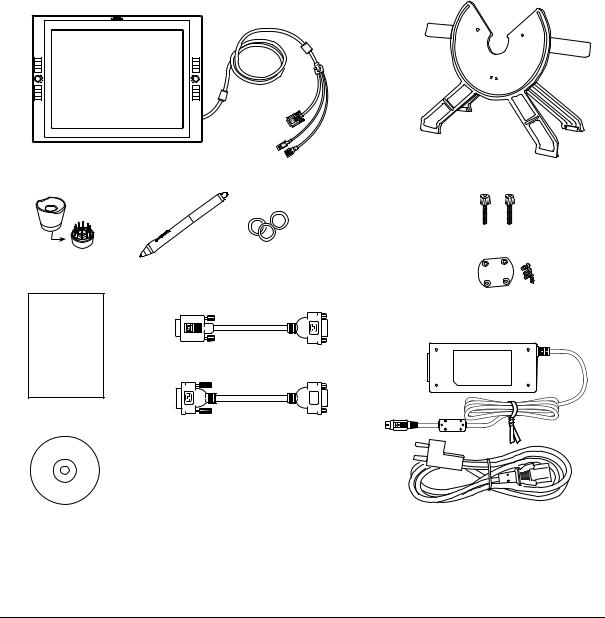
UNPACKING YOUR CINTIQ
Carefully unpack and place all items on a stable surface. Verify that contents are complete.
The product parts and accessories are packed together in the accessories box. To avoid damage, see the instructions on the following pages before setting up and using Cintiq or the Cintiq stand.
Cintiq interactive pen display, |
Cintiq stand (MST-A155) |
with attached cabling |
*Patented |
Pen stand, includes replacement nibs and nib extraction tool (PST-A042-02)
Rotation lock screws, qty 2 (MNE-A185)
Grip Pen, pen personalization rings (KP-501E-01, FUZ-A157)
Bearing hub recess cover plate and screws (PPL-A274 and MNE-A186)
VGA to DVI-I adapter (STJ-A291)
User’s manual (this manual)
DVI-D to DVI-I adapter (STJ-A292)
Installation CD |
Power supply (POW-A111) |
|
and |
|
power cable (SCD-A069-01) |
Note: Some configurations may include additional CDs or DVDs containing application software. To install, see the instructions for those CDs or DVDs. Retain the package box for use when storing or shipping Cintiq.
Next step: Set up the Cintiq stand. See page 10.
Unpacking your Cintiq
Page 9
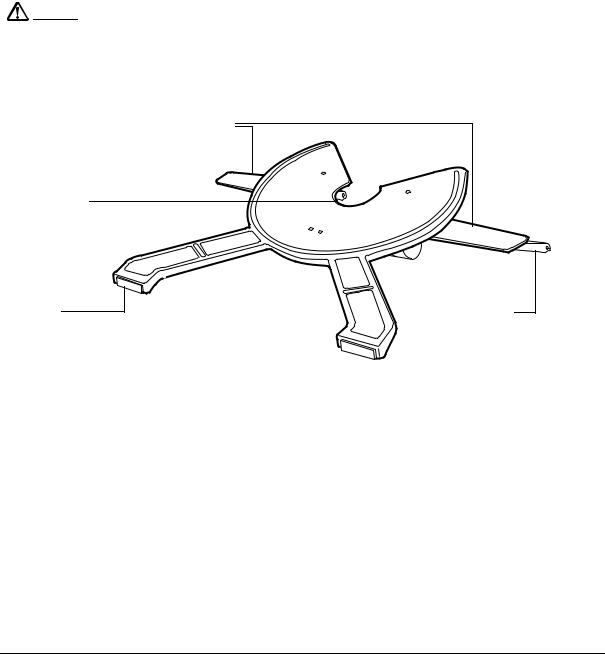
SETTING UP THE CINTIQ STAND
Place the stand on your desktop or work surface. Make sure the stand is stable and will not tip or fall when the pen display is mounted on it. Then familiarize yourself with the stand components.
Do not operate the incline adjustment levers when Cintiq is not mounted on the stand, and do Warning not lift the stand by the adjustment levers. The stand is spring-loaded and may cause injury or
damage if released without the weight of Cintiq on the stand. Improper operation may lead to physical injury or damage to the stand. Be careful to avoid catching your finger in the gap of the movable portion of the stand.
Incline adjustment levers
When Cintiq is mounted on the stand, use these levers to adjust the display incline, as described in “Adjusting the display incline” on page 12.
Bearing recess
Front feet
The front feet have rubber pads to reduce slippage on the desktop.
Rear feet
The rear feet are on rollers, allowing them to move when adjusting incline.
Next step: Unpack the pen display and mount it on the Cintiq stand. See page 11.
Unpacking your Cintiq
Page 10

UNPACKING AND MOUNTING THE CINTIQ PEN DISPLAY
Remove any packing materials from the back of the display unit and cabling. Mount Cintiq on the stand:
•Make sure the stand is placed in a stable position on your desktop or other work surface so that it will not tip or fall when Cintiq is mounted on it. Securely grasp Cintiq with both hands; the display should face toward you, with the power switch and LEDs located at the top.
•Align Cintiq parallel to the front of the stand so the bearing hub is located between the V-shaped upper edges of the stand’s bearing recess. The V-shaped edges will serve as a guide for positioning the bearing hub. See – A – below.
•With the back of Cintiq resting against the stand, lower Cintiq until the bearing hub rests securely in the bearing recess. See – B – on the following page. The display unit will be held in place by gravity; there will be no audible ‘snap’ to indicate a mechanical lock.
Bearing hub
Bearing recess
– A –
If you do not need to rotate the Cintiq pen display, you can secure it to the stand with the rotation lock screws. See “Optional display configurations” on page 61.
To learn about other mounting options, see “Using an alternate mount or stand” on page 62.
Unpacking your Cintiq
Page 11
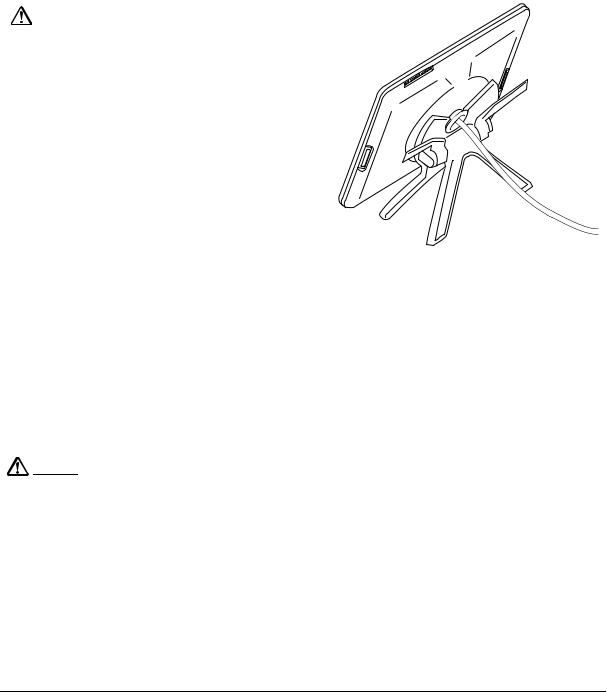
Warning |
When operating the incline adjustment levers, |
|
|
Cintiq must be mounted on the stand with the |
|
||
|
|
|
|
|
|
stand feet resting on a stable, flat surface. |
|
|
|
The stand is spring-loaded and can snap back |
|
|
|
quickly, causing injury or damage if not |
– B – |
|
|
operated properly. |
|
After the display unit has been mounted on the stand, remove the foam blocks that lock the adjustment levers in place. Save these blocks with the other packaging materials; you will need them if in the future you want to ship Cintiq.
ADJUSTING THE DISPLAY INCLINE
To adjust the display incline, face the front of the Cintiq pen display and grasp it on the left and right side at approximately the same height as the Cintiq stand adjustment levers. Use your fingertips to gently pull the incline adjustment levers toward the display unit; this will release the stand’s clutch mechanism. Tilt the display to adjust the incline setting.
•To lower Cintiq, pull the left incline adjustment lever toward Cintiq and gently lower Cintiq to the desired incline angle. Release the lever to lock the stand in place.
•To raise Cintiq, pull the right incline adjustment lever toward Cintiq and gently raise Cintiq to the desired incline angle. Release the lever to lock the stand in place.
Note: The stand adjustment levers exhibit some natural play before the clutch mechanism engages. When adjusting the stand incline, set it slightly higher than you plan to work with, then lower the display to the desired position.
Before moving Cintiq, first adjust the stand to its full upright position; this will reduce the spring Warning tension so the stand will not accidentally release and snap shut. If the display unit is in
landscape orientation, use one hand to grasp the bottom of the display and with your other hand grasp the back of the stand. Be sure to lift on both the display and the stand so the stand will not separate from the display when moving Cintiq. If Cintiq is in portrait orientation or has been locked to the stand with the rotation lock screws (see page 61), the stand will not separate from the display unit and Cintiq can be safely lifted by grasping the display unit with both hands.
Next step: Go to page 14 and familiarize yourself with the pen display.
Unpacking your Cintiq
Page 12
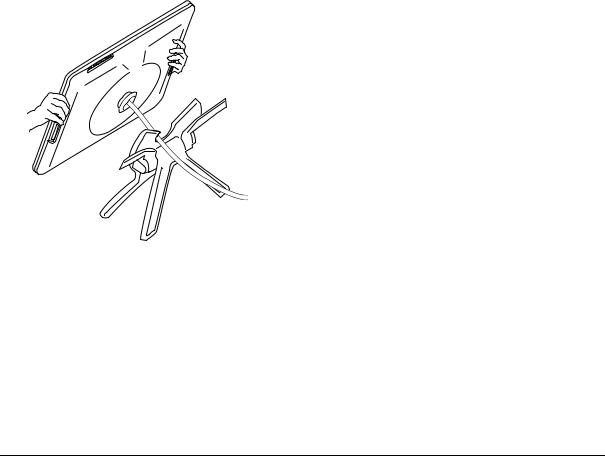
ADJUSTING ROTATION
To adjust rotation, grasp Cintiq by the main body and rotate the unit to the desired position; it will move on the bearing hub. Cintiq can be rotated on the display stand when the incline is less than or equal to 25 degrees. You can only rotate the pen display 180 degrees in either direction. If you do not plan to rotate the pen display, use the rotation lock screws and fasten the display to the stand in a horizontal position. See “Optional display configurations” on page 61.
REMOVING CINTIQ FROM THE DISPLAY STAND
To remove Cintiq from the display stand:
•If the rotation lock screws are attached, remove them from the back of Cintiq.
•Position the pen display to landscape orientation before removing it from the display stand. The stand will not release unless Cintiq is in landscape orientation.
•Next, raise the stand incline to the highest position. See “Adjusting the display incline” on page 12.
•Firmly grasp the pen display on both the left and right sides of the unit, and lift out of the display stand.
Important: When removing Cintiq from the display stand, always lift Cintiq in a direction parallel to the front of the stand. You may also need to slightly rotate Cintiq so the stand will release.
Note: When packing Cintiq for transport, first adjust the stand to its lowest position and place the foam packing blocks under the incline adjustment levers before removing Cintiq from the stand. The foam blocks will keep the stand from snapping shut while in its packaging. Always pack Cintiq and its stand in their original containers and protective cushions. Never pack Cintiq while it is mounted on the stand; this may damage the unit or stand during transport.
Unpacking your Cintiq
Page 13
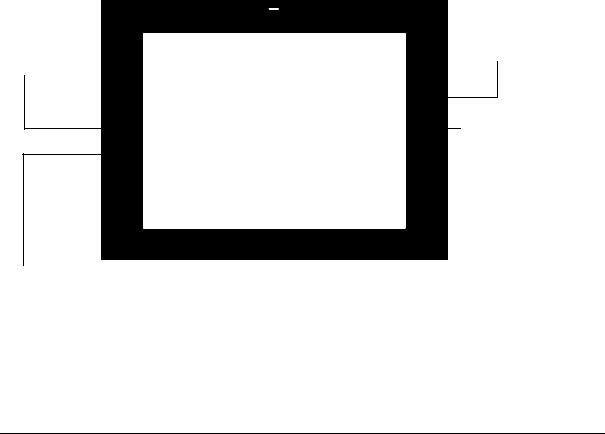
YOUR CINTIQ INTERACTIVE PEN DISPLAY
After the Cintiq pen display is safely mounted on the Cintiq stand, take some time to familiarize yourself with the features and components of your product.
The display and tablet sensor function as an integrated output and input device. The tablet sensor reports pen coordinates, pressure, tilt, switch, eraser, and other information.
FRONT VIEW
Status LED |
Power switch |
||||||||
Lights blue when pen is in active area of |
Turns unit on or off. |
||||||||
the pen display and the pen tip, eraser, or |
|
|
|
|
|
|
|
|
|
|
|
|
|
|
|
|
|
||
side switch are pressed. |
|
|
|
|
|
|
|
|
|
LED will not light unless the USB cable |
|
|
|
|
|
|
|
|
|
connector is plugged into an active USB |
|
|
|
|
|
|
|
|
|
port and a video signal is present. |
|
|
|
|
|
|
|
|
|
|
|
|
|
|
|
|
|
|
|
|
|
|
|
|
|
|
|
|
|
|
|
|
|
|
|
|
|
|
|
Touch Toggle button
ExpressKeys
These customizable keys simulate modifier keys, keystrokes, and other frequently used functions. A Display Toggle function is also available, enabling you to toggle the screen cursor between the Cintiq pen display and your other displays. See “Pen display controls” on page 30.
Power LED
Lights blue when power has been supplied to Cintiq and a video signal is present.
Glows orange when no video signal is detected. (e.g., Your computer is turned off, starting up, or has entered a power management mode in which video signals are not sent.)
ExpressKeys
Touch Toggle button
Press to toggle between Touch Strip functions. See “Pen display controls” on page 30.
LEDs indicate which of the four Touch Strip functions are active.
Your Cintiq interactive pen display Page 14

REAR VIEW
On Screen Display (OSD) controls
Use these controls to adjust a variety of display settings. See “Adjusting the display” on page 38.
Digital/Analog (DVI/VGA) switch
Set this switch for the video connection you will be using.
Bearing hub
Fits into the bearing recess on the Cintiq stand. Allows rotation of Cintiq, and easy mounting and removal from the stand.
Touch Strip
Security slot
Integrated pen holder and alternate cable exit
The pen can be stored here. If you are not using the Cintiq stand supplied with the unit, you can route the cable to exit from this location. See “Using an alternate mount or stand” on page 62.
Touch Strip
Slide your finger over the Touch Strips to zoom,
scroll, or perform custom keystroke actions.
See “Pen display controls” on page 30.
Pen tether attachment point
One located on each side of unit.
 Cabling and connectors
Cabling and connectors
The connectors on the integrated cable are for DVI-I video, USB data, and power.
Important: Always store the interactive pen display on the Cintiq display stand or in its original packing carton when not in use. Do not store the display unit on a surface that would excessively bend or crimp the cable.
Next step: See “Installation” on page 17.
Your Cintiq interactive pen display
Page 15
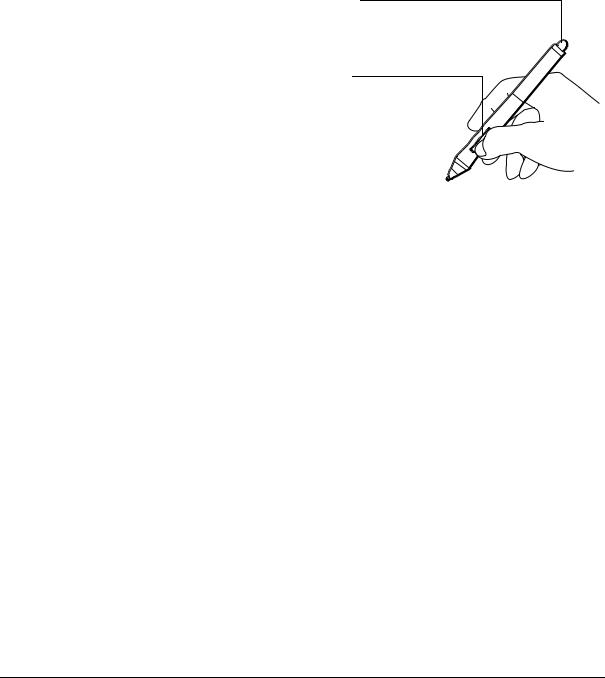
PEN FEATURES
Eraser: When brought within proximity of the pen display (5 mm (0.2 inch)), the tablet portion of the display reports the pen location. Pressure information is reported as you press down on the eraser. By default, the eraser function is set to ERASE.
DuoSwitch: Be sure the programmable switch is in a convenient location where you can toggle it with your thumb or forefinger but not accidentally press it while using the pen. You can use the switch whenever the pen tip is within proximity of the display screen surface; you do not need to touch the pen tip to the display surface.
Toggle the switch in either direction to activate the button functions. By default, the upper switch is set to DOUBLE CLICK and the lower switch is set to RIGHT CLICK.
Pen tip (replaceable nib): The pen is activated as soon as it is  brought within proximity (5 mm (0.2 inch)) of the pen display screen.
brought within proximity (5 mm (0.2 inch)) of the pen display screen.
This allows you to position the screen cursor without touching the pen tip to the display screen.
When pressure is applied to the pen tip, the pen simulates a primary mouse button click. Tip click pressure can be adjusted in the Wacom Tablet control panel.
Important: Only use a pen that is compatible with Cintiq, such as the pen that shipped with the unit, or pens from the Intuos4 product line which have a part number ending in “-01”. Other pens may not function properly. See “Available parts and accessories” on page 72. Also, the Cintiq pen tip is specifically designed for use with the Cintiq pen display. The tips on other pens could damage the Cintiq display screen.
When the pen is not in use, place it in the pen stand, the pen holder, or lay it flat on your desk. To maintain the sensitivity of your pen, do not store it in a container where it will rest on its tip or eraser.
Your Cintiq interactive pen display
Page 16

INSTALLATION
The computer treats the interactive pen display as two separate devices (the display and the pen tablet). Therefore, the installation process is completed in two stages:
•First install as a display.
•Then install as a pen tablet.
Both stages require hardware and software installations and adjustments. Carefully follow ALL instructions.
Important: You MUST install the Wacom driver software for correct pen-on-screen functionality.
SYSTEM REQUIREMENTS
Make sure your computer meets the following minimum system requirements:
•PC. Windows 7, Vista™, XP (32 and 64 bit). DVI or VGA connector, available USB port, and CD-ROM drive.
•Macintosh. OS X, v10.4 or greater. DVI or VGA connector, available USB port, and CD-ROM drive.
Cintiq supports both digital (DVI) and analog (VGA) video signals. If updating your video card, first complete the video card installation before connecting Cintiq. If you have another display that is compatible with your video card, you can use that display to verify the video card is operating correctly.
Although you can connect Cintiq to either a DVI or VGA video card, connecting to a DVI video card generally results in optimum performance.
Notes:
Cintiq can be used alone or with another display, such as a CRT monitor or LCD projector. To use Cintiq with another display, you will need two video cards or a video card with dual output.
You may be able to set up Cintiq as a mirrored, extended, or independent display.
When working with more than one monitor, Cintiq will map to the monitors based upon how your system is configured. By default, if you are in mirror mode, the pen display will map to the entire space on each monitor. See your hardware and operating system documentation for details on configuring your system for use with multiple monitors.
A Display Toggle function is available for use with multiple display systems. This enables you to toggle the screen cursor between Cintiq and your other displays.
Installation
Page 17
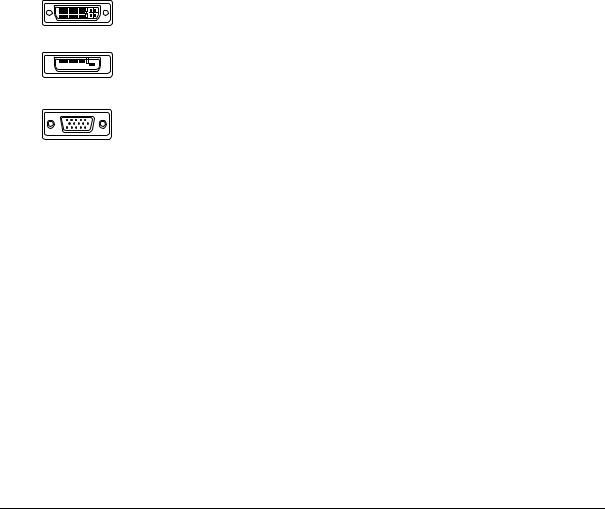
STEP 1: DISPLAY INSTALLATION
In this step, Cintiq is installed as a display on your system.
Important: Never connect or disconnect the video or power cables while your computer or pen display are powered on. This can damage the display or video card.
1.Turn off your computer.
2.If your computer has only one video connector, unplug your previous monitor or add a second video card. Determine if your computer has a digital (DVI) or analog (VGA) connector, and set the DVI/VGA switch located on the back of Cintiq for the video connection you are using. Move the switch toward the tablet edge for Digital (DVI-I or DVI-D), and move it toward the OSD buttons for Analog (VGA). See – A – in the connection diagram on page 19.
3.Making sure to tighten the connector thumbscrews, follow the below instructions for your video connector. See – B – in the connection diagram.
For DVI-I operation, plug the Cintiq video cable into the DVI-I connector of your video card.
DVI-I connector
For DVI-D operation, plug the Cintiq video cable into the DVI-D to DVI-I adapter supplied with Cintiq, and then plug the adapter into the DVI-D connector on your












 video card. DVI-D connector
video card. DVI-D connector
For VGA operation, plug the Cintiq video cable into the VGA to DVI-I adapter
supplied with Cintiq, and then plug the adapter into the VGA connector on your video card.
VGA connector
If connecting to a Mac Mini DisplayPort, you will need to obtain an appropriate adapter. For best results the Apple Mini DisplayPort to Dual-Link DVI Adapter is recommended. Adapters can be purchased at various retail outlets and through the online Apple Store.
Connect the adapter between the Cintiq video cable and your Macintosh.
4.Connect the power adapter to Cintiq. See – C – on the next page.
5.Connect the adapter power cable and plug into an AC outlet. See – D – in the connection diagram.
6.Turn on Cintiq. The power LED will light orange.
Installation
Page 18

DISPLAY CABLING DIAGRAM
– A –
DVI/VGA switch
Rear panel of computer
Video card
DVI or VGA
Cintiq, rear view
– B –
DVI-I connector
To connect to a DVI-D connector, use the
DVI-D to DVI-I adapter.
To connect to a VGA connector, use the
VGA to DVI-I adapter.
To AC outlet
– C –
DC input
– D – Power adapter
Caution |
Make sure your video card has a DVI or VGA connector, and that you correctly set the Cintiq |
|
DVI/VGA switch for the video connector you are using. |
||
|
||
|
Use only a power adapter specified for use with Cintiq; use of an improper power adapter may |
|
|
damage the unit. |
|
|
Do not connect or disconnect the video or power cables while Cintiq or your computer are |
|
|
turned on. This can damage the display or computer video card. |
|
|
Make sure the display refresh rate does not exceed the maximum vertical frequency that Cintiq |
|
|
can support. See the “Product specifications” on page 68 for details. |
|
|
|
|
|
Installation |
|
|
Page 19 |

7.Next, turn on your computer.
For Windows: The interactive pen display will automatically install as a default monitor. To identify the unit as a pen display and install the color calibration profile:
A)Open the system CONTROL PANEL folder.
•For Windows 7 and Vista, under APPEARANCE AND PERSONALIZATION select ADJUST
SCREEN RESOLUTION.
•For Windows XP, open the DISPLAY PROPERTIES control panel and select the SETTINGS tab.
If you have more than one monitor, click IDENTIFY MONITORS to determine which display corresponds to the pen display. Select the number corresponding to the pen display.
B)Click ADVANCED SETTINGS....
C)Select the MONITOR tab and click PROPERTIES.
D)Select the DRIVER tab and click UPDATE DRIVER.... An update driver dialog or Wizard will appear.
E)Insert the Installation CD. If the Wacom Tablet installation menu displays, close it. Windows 7 and Vista:
•Select BROWSE MY COMPUTER FOR DRIVER SOFTWARE.
•Enter the drive letter for the Installation CD and click NEXT.
•After installation is complete, close any open control panel windows.
Windows XP:
•The Wizard will ask if Windows can search for software. Choose NO, NOT THIS TIME and click NEXT.
•Select INSTALL FROM A LIST OR SPECIFIC LOCATION (ADVANCED), and click NEXT.
•Select DON’T SEARCH. I WILL CHOOSE THE DRIVER TO INSTALL and click NEXT.
•Select the pen display option and click HAVE DISK.... Enter the letter of your CD-ROM drive (e.g., E:\), and click OK.
•Follow the prompts. (If the HARDWARE INSTALLATION dialog box displays, click CONTINUE ANYWAY.) After installation is complete, click FINISH and close any open control panel windows.
For Macintosh, a color profile is added to your color management system during the driver software installation process. To activate this color profile for use with Cintiq, you may need to select the Cintiq profile in the system’s ColorSync Utility control panel. For details, see the color management information in your operating system and application documentation.
Installation
Page 20

8.As necessary, configure the display control panel settings for the proper size and color resolution. See the “Product specifications” on page 68 for details about the maximum (native) resolution and other resolution sizes that can be used with Cintiq. The display size and color resolution may be constrained by the capabilities of your video card.
Windows: If you are using Cintiq as a secondary display, you may first need to enable the unit in your display properties control panel.
To fine-tune the display, see “Adjusting the display” on page 38. If using analog (VGA) mode, see also “Adjusting pitch and phase (VGA only)” on page 37.
9.After the LCD monitor portion of the installation is working to your satisfaction, move on to Step 2: pen tablet installation.
For troubleshooting tips, see “Troubleshooting” on page 42.
Notes:
Each interactive pen display LCD panel is produced under very stringent quality standards. Production techniques cannot guarantee an absolutely perfect display, and some panels may exhibit a certain number of pixels that show an incorrect color. See the “Product specifications” on page 68 for more information.
If an image has fine striping (such as screen stripes), it may appear to flicker or display a moiré pattern.
Do not apply excessive pressure on the display screen surface, it may cause the appearance of a moiré or pooling pattern. If this occurs, use less pressure on the display screen when working with the pen.
When a still image is displayed for a long period of time, an after-image may remain for a short time. To prevent this, use a screen saver or other power management feature.
To extend the life of the pen display backlight, set your computer’s power management to turn off the display when it is not in use for extended periods of time.
Installation
Page 21

STEP 2: PEN TABLET INSTALLATION
In this step, Cintiq is installed as a pen tablet.
USB CABLE INSTALLATION
Plug the USB connector into an available USB port on your computer or into a USB hub attached to your computer.
To USB port
Computer
Next, install the pen tablet software. See “Software installation” on page 23.
Installation
Page 22

SOFTWARE INSTALLATION
Important: You MUST install the Wacom driver software for correct pen-on-screen functionality. Save your work and close all open applications. Temporarily disable any virus protection programs.
•Insert the Installation CD into your computer’s CD-ROM drive. If the software installer menu does not automatically display, double-click on the INSTALL icon located on the CD.
•Click INSTALL TABLET and follow the prompts to install the driver software.
•Reactivate your virus protection program.
•After completing the software installation, make sure you can use your pen on the Cintiq display screen to move the screen cursor.
When you place the pen tip on the display screen, the screen cursor should immediately jump to a corresponding position approximately beneath the pen tip. Lift the pen tip and place it on the display screen surface in a different location. The screen cursor should again jump to the new position. This is known as absolute positioning, and enables you to position the screen cursor without having to drag your pen across the display screen surface.
•Be sure to check the Read Me file for updated information. If you have trouble installing Cintiq, see “Troubleshooting” on page 42.
Notes:
Driver installation automatically activates the new pen input functions available within Microsoft Windows 7, Vista, and Office 2007 or later (except for Windows 7 Starter and Home Basic, and Windows Vista Home Basic). Visit the Wacom web site at www.wacom.com/vista for additional information on using your Wacom pen in Windows.
User-specific preferences are supported. After logging in, each user can customize their personal settings in the Wacom Tablet control panel. Switching to another user will automatically load the settings for that user.
If the pen display does not respond properly or you lose cursor control, the pen display preferences may be corrupted. You can delete the current preference settings and return the pen display to its factory default condition. See the Software User’s Manual for details on managing preferences.
To uninstall the software driver, see “Uninstalling Cintiq” on page 67.
Next, see “Calibrating Cintiq” on page 36 to precisely align the screen cursor to the pen tip.
Installation
Page 23
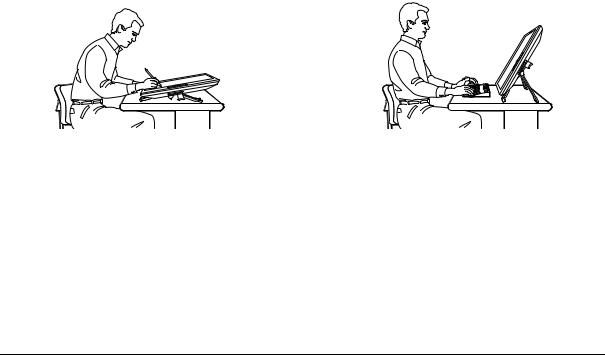
WORKING WITH YOUR CINTIQ
As you work with Cintiq, you can rest your hand lightly on the display screen, just as if it were a drawing board or sheet of paper.
Because the Cintiq pen display surface will be a little higher than your desk, consider adjusting the height of your desk or chair to assure comfortable use of the device.
SETTING UP YOUR WORK AREA
The Cintiq interactive pen display and stand were designed to provide you with the widest possible range of flexibility and ergonomic work approach. The design allows you to quickly adjust Cintiq to a different position whenever the need arises. Experiment with different height and position adjustments to determine which best fits your particular working style and tasks.
To minimize fatigue, organize your work area so you can work comfortably. Position Cintiq, the pen, and your keyboard for easy access without unnecessary reaching. The pen display and any other displays should be positioned so you can view them comfortably with a minimum of eyestrain.
•Take short breaks between tasks to stretch and relax your muscles.
•Use a gentle grip when working with the pen.
•Alternate tasks throughout the day.
•Maintain a good posture at all times. Minimize awkward postures and repetitive movements that cause discomfort.
•Change your position if you feel any discomfort due to your work position.
•Alternate between different modes of use.
To emulate a traditional animator’s table, adjust the stand to its lowest position. Cintiq can be freely rotated to any angle without touching the desktop for the greatest comfort and accuracy of stroke while drawing or editing images.
Adjustment of the stand to its highest position is common when your work requires a large amount of keyboard input. This position is also useful when presenting your work to co-workers or clients.
Note regarding RSI: Wacom makes no representation, promise or guarantee that Wacom products will cure or prevent, in whole or in part, mouse-induced repetitive stress symptoms, injuries or conditions. Individual results may vary. Always obtain competent medical advice to determine the most appropriate treatment for your specific situation.
Working with your Cintiq
Page 24

Tips:
If the rotation lock screws are attached to the back of Cintiq, they must be removed before Cintiq can be rotated.
Before rotating the display unit, be sure the cable is freely rotating behind the unit.
Do not pull the cable out of its computer connections by accidentally moving the pen display too far from the computer.
Cintiq can also be mounted to articulated arms or other third-party stands meeting the VESA 100 specification for monitor stands. See “Using an alternate mount or stand” on page 62 for details.
Next step: If you have not already done so, learn about the basics of customizing your product for the way you like to work. See “Customizing” on page 34.
Working with your Cintiq
Page 25
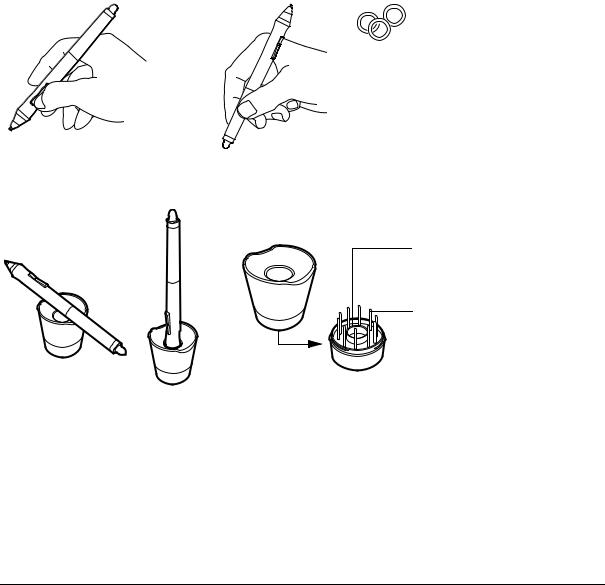
USING THE GRIP PEN
The pen is cordless, battery-free, and senses the amount of tilt and pressure you exert upon it.
HOLDING THE PEN
Hold the pen like you would a normal pen or pencil. Make sure the DuoSwitch is in a convenient location where you can toggle it with your thumb or forefinger, but not accidentally press it while drawing. As you work with Cintiq you can rest your hand lightly on the display screen. You can tilt the pen in any way that feels most comfortable.
To personalize your pen, unscrew the tip cone and replace the colored ring with one of another color (included).
Refer to “Customizing” on page 34 and to the electronic Software User’s Manual for information on customizing the pen settings.
Place the pen stand within easy reach. When the pen is not in use, place it in the pen stand, the pen holder, or lay it flat on your desk. The stand allows for vertical or horizontal placement of the pen.
To maintain the sensitivity of your pen, do not store it in a container where it will rest on its tip or eraser.
Unscrew the base of the pen stand to access a nib extraction tool and assorted replacement nibs.
Nib extractor
Replacement nibs
• 6 standard nibs, black
• 1 stroke nib, white
• 3 hard felt nibs, gray
Working with your Cintiq
Page 26
